Financial Management Report: Case Study, Analysis, and Improvement
VerifiedAdded on 2022/12/26
|12
|3094
|25
Report
AI Summary
This report provides a comprehensive overview of financial management, emphasizing its importance in business operations. It delves into key financial statements, including the profit and loss statement, balance sheet, cash flow statement, and statement of shareholder's equity, highlighting their significance in assessing a company's financial health. The report also explores the application of ratio analysis, focusing on profitability and liquidity ratios, to evaluate a company's performance and financial position. Furthermore, it presents a case study analysis, applying the concepts discussed to a specific business scenario. Based on this analysis, the report suggests practical processes and strategies for enhancing the financial performance of the business, such as cost reduction, debt management, and improved working capital management. The report concludes by summarizing the importance of financial management and providing recommendations for improved financial health.

3005
Paraphrase This Document
Need a fresh take? Get an instant paraphrase of this document with our AI Paraphraser
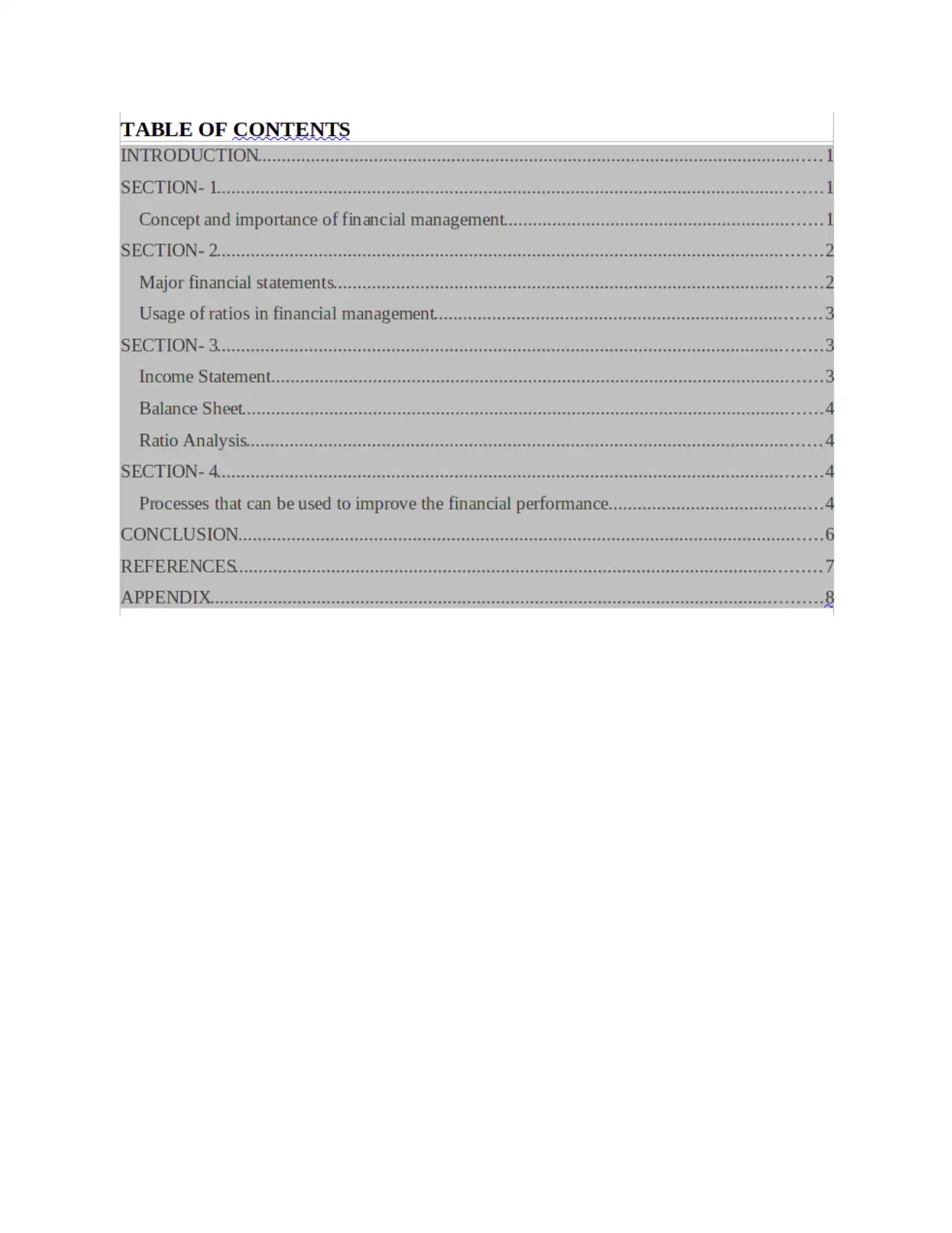
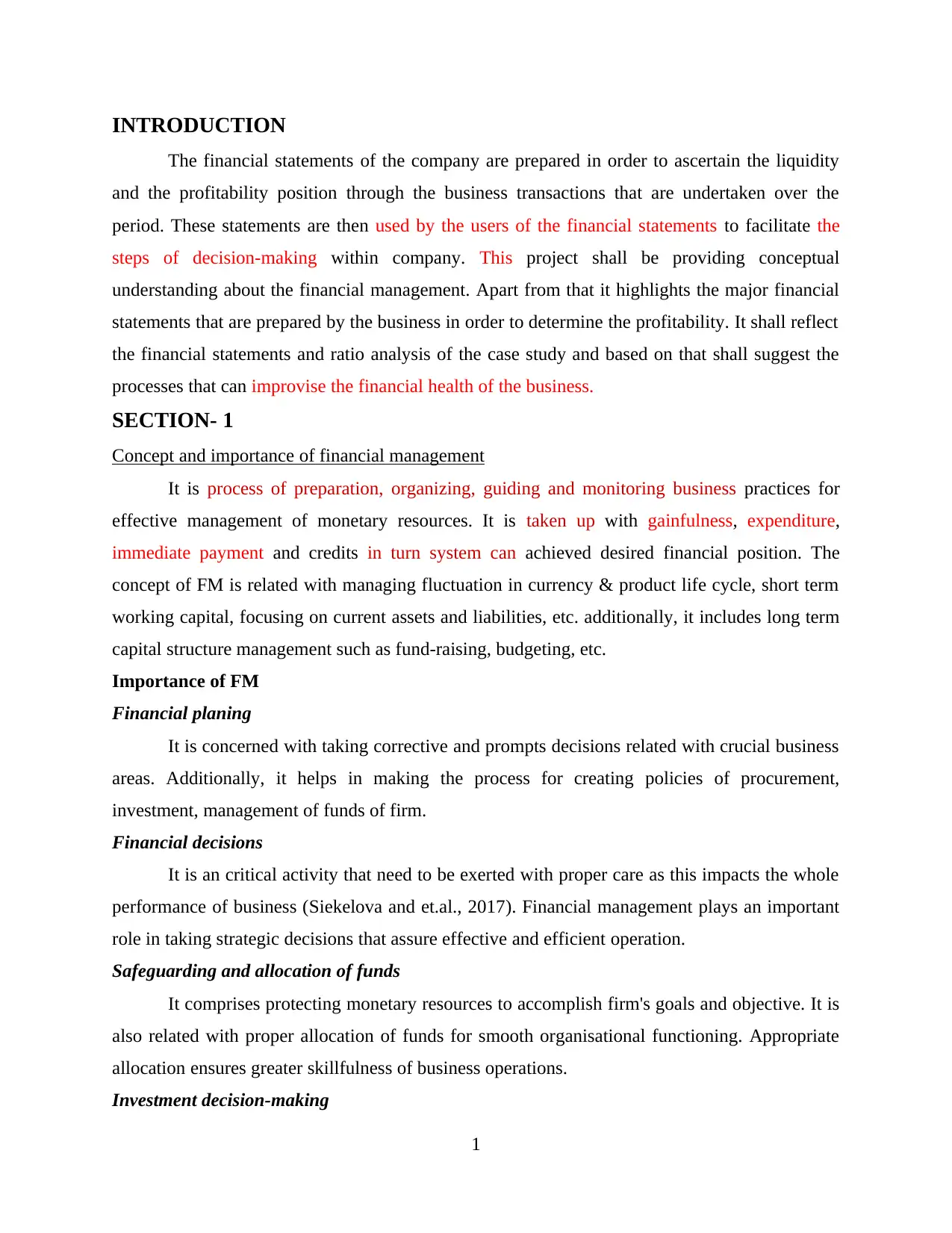
INTRODUCTION
The financial statements of the company are prepared in order to ascertain the liquidity
and the profitability position through the business transactions that are undertaken over the
period. These statements are then used by the users of the financial statements to facilitate the
steps of decision-making within company. This project shall be providing conceptual
understanding about the financial management. Apart from that it highlights the major financial
statements that are prepared by the business in order to determine the profitability. It shall reflect
the financial statements and ratio analysis of the case study and based on that shall suggest the
processes that can improvise the financial health of the business.
SECTION- 1
Concept and importance of financial management
It is process of preparation, organizing, guiding and monitoring business practices for
effective management of monetary resources. It is taken up with gainfulness, expenditure,
immediate payment and credits in turn system can achieved desired financial position. The
concept of FM is related with managing fluctuation in currency & product life cycle, short term
working capital, focusing on current assets and liabilities, etc. additionally, it includes long term
capital structure management such as fund-raising, budgeting, etc.
Importance of FM
Financial planing
It is concerned with taking corrective and prompts decisions related with crucial business
areas. Additionally, it helps in making the process for creating policies of procurement,
investment, management of funds of firm.
Financial decisions
It is an critical activity that need to be exerted with proper care as this impacts the whole
performance of business (Siekelova and et.al., 2017). Financial management plays an important
role in taking strategic decisions that assure effective and efficient operation.
Safeguarding and allocation of funds
It comprises protecting monetary resources to accomplish firm's goals and objective. It is
also related with proper allocation of funds for smooth organisational functioning. Appropriate
allocation ensures greater skillfulness of business operations.
Investment decision-making
1
The financial statements of the company are prepared in order to ascertain the liquidity
and the profitability position through the business transactions that are undertaken over the
period. These statements are then used by the users of the financial statements to facilitate the
steps of decision-making within company. This project shall be providing conceptual
understanding about the financial management. Apart from that it highlights the major financial
statements that are prepared by the business in order to determine the profitability. It shall reflect
the financial statements and ratio analysis of the case study and based on that shall suggest the
processes that can improvise the financial health of the business.
SECTION- 1
Concept and importance of financial management
It is process of preparation, organizing, guiding and monitoring business practices for
effective management of monetary resources. It is taken up with gainfulness, expenditure,
immediate payment and credits in turn system can achieved desired financial position. The
concept of FM is related with managing fluctuation in currency & product life cycle, short term
working capital, focusing on current assets and liabilities, etc. additionally, it includes long term
capital structure management such as fund-raising, budgeting, etc.
Importance of FM
Financial planing
It is concerned with taking corrective and prompts decisions related with crucial business
areas. Additionally, it helps in making the process for creating policies of procurement,
investment, management of funds of firm.
Financial decisions
It is an critical activity that need to be exerted with proper care as this impacts the whole
performance of business (Siekelova and et.al., 2017). Financial management plays an important
role in taking strategic decisions that assure effective and efficient operation.
Safeguarding and allocation of funds
It comprises protecting monetary resources to accomplish firm's goals and objective. It is
also related with proper allocation of funds for smooth organisational functioning. Appropriate
allocation ensures greater skillfulness of business operations.
Investment decision-making
1
⊘ This is a preview!⊘
Do you want full access?
Subscribe today to unlock all pages.

Trusted by 1+ million students worldwide
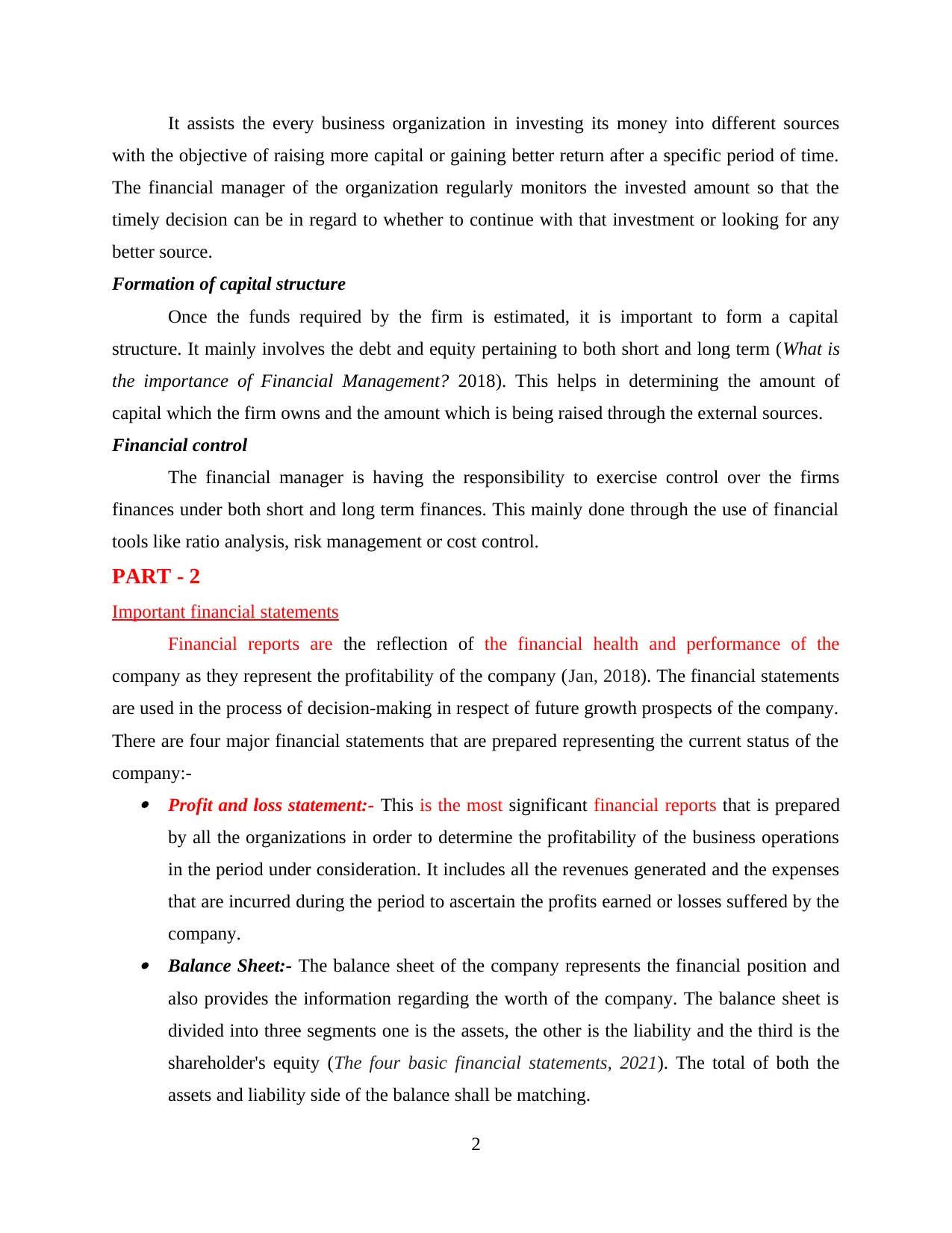
It assists the every business organization in investing its money into different sources
with the objective of raising more capital or gaining better return after a specific period of time.
The financial manager of the organization regularly monitors the invested amount so that the
timely decision can be in regard to whether to continue with that investment or looking for any
better source.
Formation of capital structure
Once the funds required by the firm is estimated, it is important to form a capital
structure. It mainly involves the debt and equity pertaining to both short and long term (What is
the importance of Financial Management? 2018). This helps in determining the amount of
capital which the firm owns and the amount which is being raised through the external sources.
Financial control
The financial manager is having the responsibility to exercise control over the firms
finances under both short and long term finances. This mainly done through the use of financial
tools like ratio analysis, risk management or cost control.
PART - 2
Important financial statements
Financial reports are the reflection of the financial health and performance of the
company as they represent the profitability of the company (Jan, 2018). The financial statements
are used in the process of decision-making in respect of future growth prospects of the company.
There are four major financial statements that are prepared representing the current status of the
company:- Profit and loss statement:- This is the most significant financial reports that is prepared
by all the organizations in order to determine the profitability of the business operations
in the period under consideration. It includes all the revenues generated and the expenses
that are incurred during the period to ascertain the profits earned or losses suffered by the
company. Balance Sheet:- The balance sheet of the company represents the financial position and
also provides the information regarding the worth of the company. The balance sheet is
divided into three segments one is the assets, the other is the liability and the third is the
shareholder's equity (The four basic financial statements, 2021). The total of both the
assets and liability side of the balance shall be matching.
2
with the objective of raising more capital or gaining better return after a specific period of time.
The financial manager of the organization regularly monitors the invested amount so that the
timely decision can be in regard to whether to continue with that investment or looking for any
better source.
Formation of capital structure
Once the funds required by the firm is estimated, it is important to form a capital
structure. It mainly involves the debt and equity pertaining to both short and long term (What is
the importance of Financial Management? 2018). This helps in determining the amount of
capital which the firm owns and the amount which is being raised through the external sources.
Financial control
The financial manager is having the responsibility to exercise control over the firms
finances under both short and long term finances. This mainly done through the use of financial
tools like ratio analysis, risk management or cost control.
PART - 2
Important financial statements
Financial reports are the reflection of the financial health and performance of the
company as they represent the profitability of the company (Jan, 2018). The financial statements
are used in the process of decision-making in respect of future growth prospects of the company.
There are four major financial statements that are prepared representing the current status of the
company:- Profit and loss statement:- This is the most significant financial reports that is prepared
by all the organizations in order to determine the profitability of the business operations
in the period under consideration. It includes all the revenues generated and the expenses
that are incurred during the period to ascertain the profits earned or losses suffered by the
company. Balance Sheet:- The balance sheet of the company represents the financial position and
also provides the information regarding the worth of the company. The balance sheet is
divided into three segments one is the assets, the other is the liability and the third is the
shareholder's equity (The four basic financial statements, 2021). The total of both the
assets and liability side of the balance shall be matching.
2
Paraphrase This Document
Need a fresh take? Get an instant paraphrase of this document with our AI Paraphraser
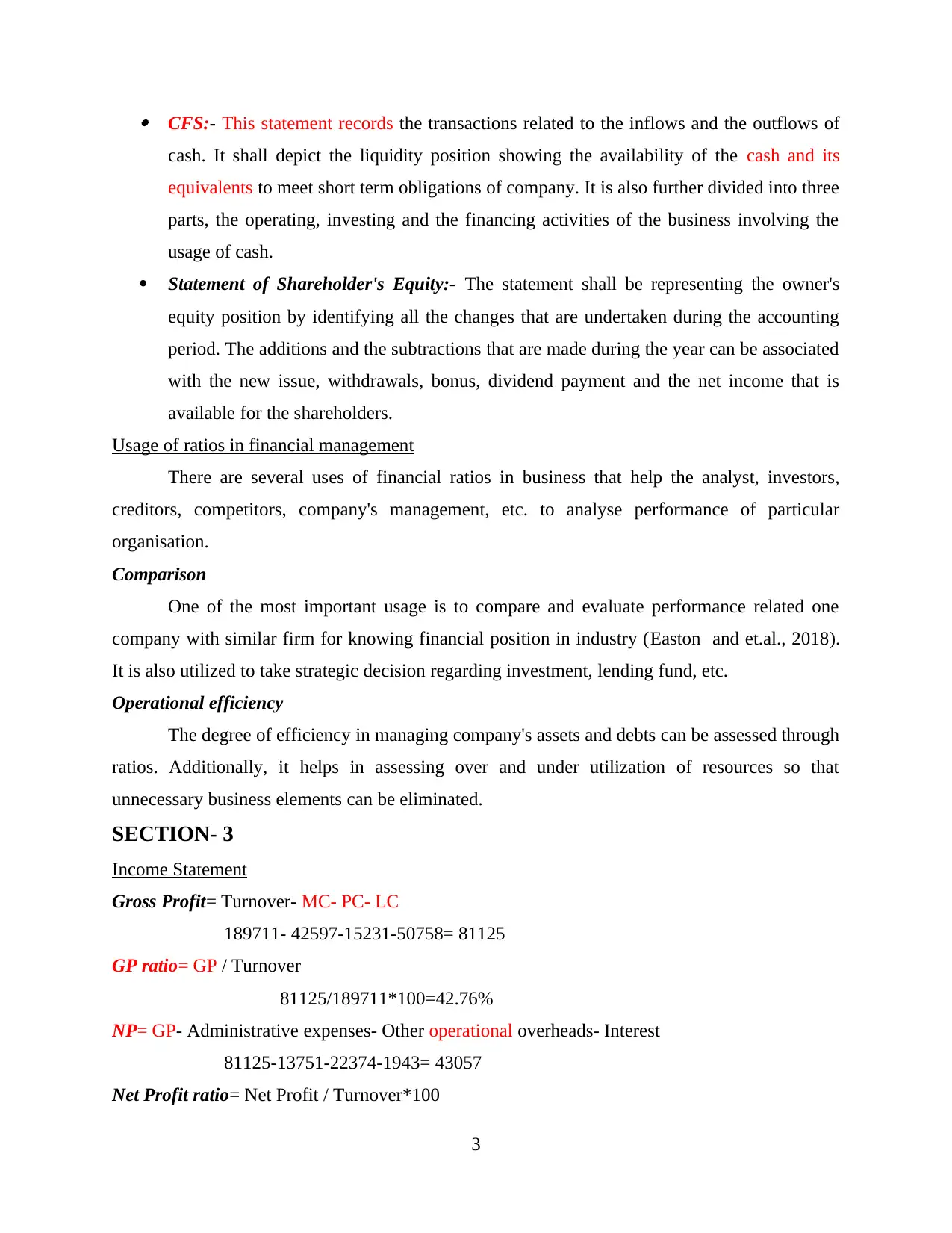
CFS:- This statement records the transactions related to the inflows and the outflows of
cash. It shall depict the liquidity position showing the availability of the cash and its
equivalents to meet short term obligations of company. It is also further divided into three
parts, the operating, investing and the financing activities of the business involving the
usage of cash.
Statement of Shareholder's Equity:- The statement shall be representing the owner's
equity position by identifying all the changes that are undertaken during the accounting
period. The additions and the subtractions that are made during the year can be associated
with the new issue, withdrawals, bonus, dividend payment and the net income that is
available for the shareholders.
Usage of ratios in financial management
There are several uses of financial ratios in business that help the analyst, investors,
creditors, competitors, company's management, etc. to analyse performance of particular
organisation.
Comparison
One of the most important usage is to compare and evaluate performance related one
company with similar firm for knowing financial position in industry (Easton and et.al., 2018).
It is also utilized to take strategic decision regarding investment, lending fund, etc.
Operational efficiency
The degree of efficiency in managing company's assets and debts can be assessed through
ratios. Additionally, it helps in assessing over and under utilization of resources so that
unnecessary business elements can be eliminated.
SECTION- 3
Income Statement
Gross Profit= Turnover- MC- PC- LC
189711- 42597-15231-50758= 81125
GP ratio= GP / Turnover
81125/189711*100=42.76%
NP= GP- Administrative expenses- Other operational overheads- Interest
81125-13751-22374-1943= 43057
Net Profit ratio= Net Profit / Turnover*100
3
cash. It shall depict the liquidity position showing the availability of the cash and its
equivalents to meet short term obligations of company. It is also further divided into three
parts, the operating, investing and the financing activities of the business involving the
usage of cash.
Statement of Shareholder's Equity:- The statement shall be representing the owner's
equity position by identifying all the changes that are undertaken during the accounting
period. The additions and the subtractions that are made during the year can be associated
with the new issue, withdrawals, bonus, dividend payment and the net income that is
available for the shareholders.
Usage of ratios in financial management
There are several uses of financial ratios in business that help the analyst, investors,
creditors, competitors, company's management, etc. to analyse performance of particular
organisation.
Comparison
One of the most important usage is to compare and evaluate performance related one
company with similar firm for knowing financial position in industry (Easton and et.al., 2018).
It is also utilized to take strategic decision regarding investment, lending fund, etc.
Operational efficiency
The degree of efficiency in managing company's assets and debts can be assessed through
ratios. Additionally, it helps in assessing over and under utilization of resources so that
unnecessary business elements can be eliminated.
SECTION- 3
Income Statement
Gross Profit= Turnover- MC- PC- LC
189711- 42597-15231-50758= 81125
GP ratio= GP / Turnover
81125/189711*100=42.76%
NP= GP- Administrative expenses- Other operational overheads- Interest
81125-13751-22374-1943= 43057
Net Profit ratio= Net Profit / Turnover*100
3
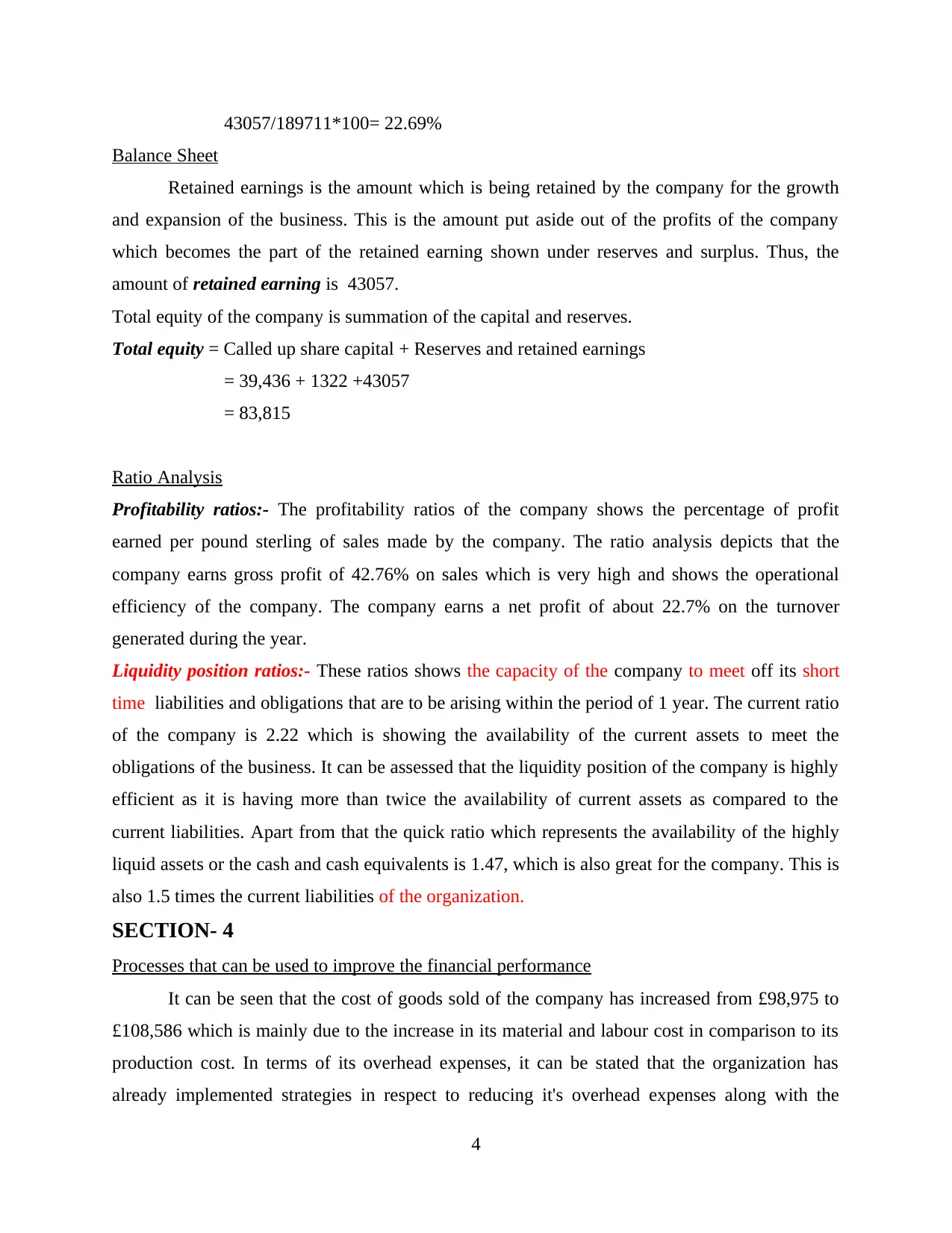
43057/189711*100= 22.69%
Balance Sheet
Retained earnings is the amount which is being retained by the company for the growth
and expansion of the business. This is the amount put aside out of the profits of the company
which becomes the part of the retained earning shown under reserves and surplus. Thus, the
amount of retained earning is 43057.
Total equity of the company is summation of the capital and reserves.
Total equity = Called up share capital + Reserves and retained earnings
= 39,436 + 1322 +43057
= 83,815
Ratio Analysis
Profitability ratios:- The profitability ratios of the company shows the percentage of profit
earned per pound sterling of sales made by the company. The ratio analysis depicts that the
company earns gross profit of 42.76% on sales which is very high and shows the operational
efficiency of the company. The company earns a net profit of about 22.7% on the turnover
generated during the year.
Liquidity position ratios:- These ratios shows the capacity of the company to meet off its short
time liabilities and obligations that are to be arising within the period of 1 year. The current ratio
of the company is 2.22 which is showing the availability of the current assets to meet the
obligations of the business. It can be assessed that the liquidity position of the company is highly
efficient as it is having more than twice the availability of current assets as compared to the
current liabilities. Apart from that the quick ratio which represents the availability of the highly
liquid assets or the cash and cash equivalents is 1.47, which is also great for the company. This is
also 1.5 times the current liabilities of the organization.
SECTION- 4
Processes that can be used to improve the financial performance
It can be seen that the cost of goods sold of the company has increased from £98,975 to
£108,586 which is mainly due to the increase in its material and labour cost in comparison to its
production cost. In terms of its overhead expenses, it can be stated that the organization has
already implemented strategies in respect to reducing it's overhead expenses along with the
4
Balance Sheet
Retained earnings is the amount which is being retained by the company for the growth
and expansion of the business. This is the amount put aside out of the profits of the company
which becomes the part of the retained earning shown under reserves and surplus. Thus, the
amount of retained earning is 43057.
Total equity of the company is summation of the capital and reserves.
Total equity = Called up share capital + Reserves and retained earnings
= 39,436 + 1322 +43057
= 83,815
Ratio Analysis
Profitability ratios:- The profitability ratios of the company shows the percentage of profit
earned per pound sterling of sales made by the company. The ratio analysis depicts that the
company earns gross profit of 42.76% on sales which is very high and shows the operational
efficiency of the company. The company earns a net profit of about 22.7% on the turnover
generated during the year.
Liquidity position ratios:- These ratios shows the capacity of the company to meet off its short
time liabilities and obligations that are to be arising within the period of 1 year. The current ratio
of the company is 2.22 which is showing the availability of the current assets to meet the
obligations of the business. It can be assessed that the liquidity position of the company is highly
efficient as it is having more than twice the availability of current assets as compared to the
current liabilities. Apart from that the quick ratio which represents the availability of the highly
liquid assets or the cash and cash equivalents is 1.47, which is also great for the company. This is
also 1.5 times the current liabilities of the organization.
SECTION- 4
Processes that can be used to improve the financial performance
It can be seen that the cost of goods sold of the company has increased from £98,975 to
£108,586 which is mainly due to the increase in its material and labour cost in comparison to its
production cost. In terms of its overhead expenses, it can be stated that the organization has
already implemented strategies in respect to reducing it's overhead expenses along with the
4
⊘ This is a preview!⊘
Do you want full access?
Subscribe today to unlock all pages.

Trusted by 1+ million students worldwide
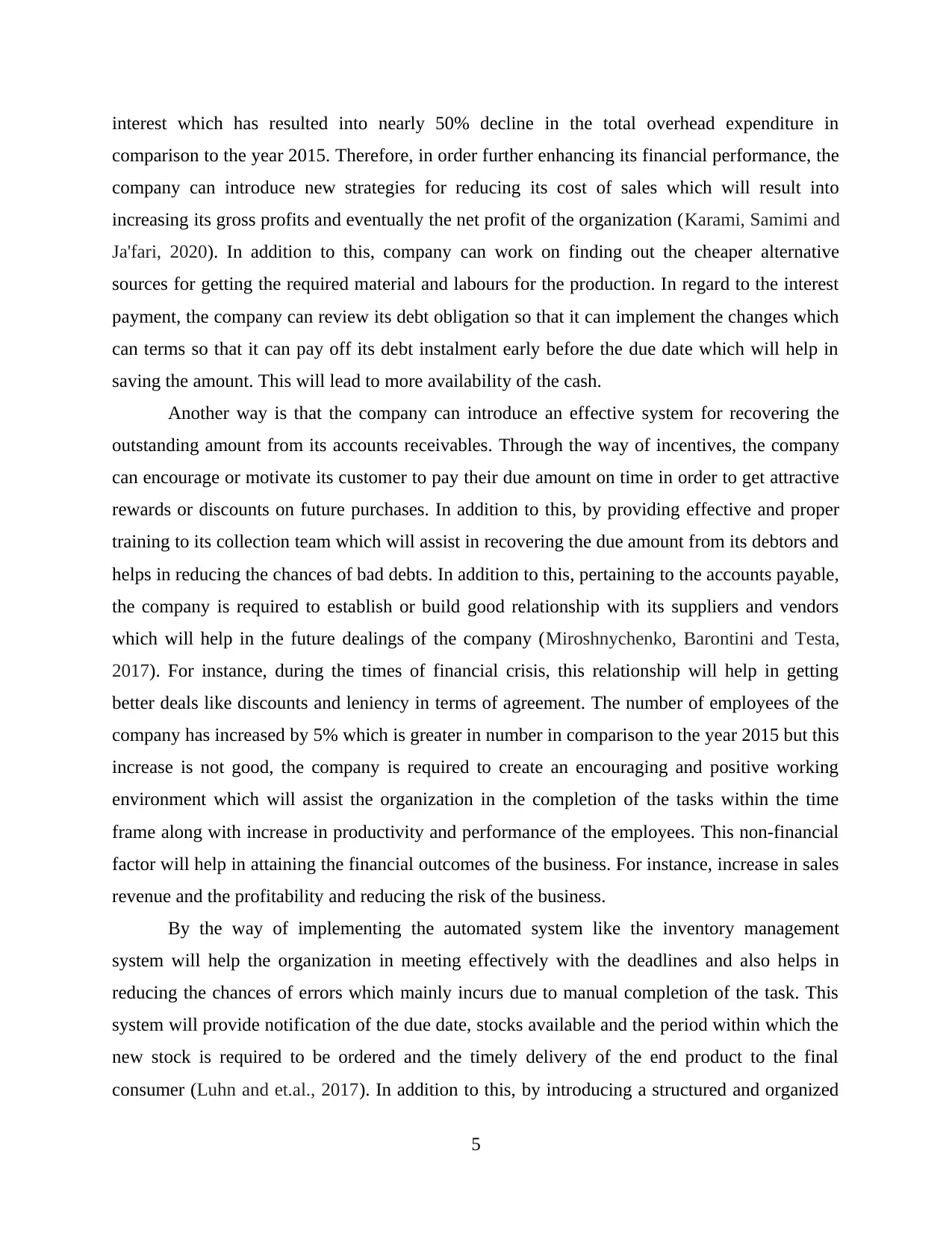
interest which has resulted into nearly 50% decline in the total overhead expenditure in
comparison to the year 2015. Therefore, in order further enhancing its financial performance, the
company can introduce new strategies for reducing its cost of sales which will result into
increasing its gross profits and eventually the net profit of the organization (Karami, Samimi and
Ja'fari, 2020). In addition to this, company can work on finding out the cheaper alternative
sources for getting the required material and labours for the production. In regard to the interest
payment, the company can review its debt obligation so that it can implement the changes which
can terms so that it can pay off its debt instalment early before the due date which will help in
saving the amount. This will lead to more availability of the cash.
Another way is that the company can introduce an effective system for recovering the
outstanding amount from its accounts receivables. Through the way of incentives, the company
can encourage or motivate its customer to pay their due amount on time in order to get attractive
rewards or discounts on future purchases. In addition to this, by providing effective and proper
training to its collection team which will assist in recovering the due amount from its debtors and
helps in reducing the chances of bad debts. In addition to this, pertaining to the accounts payable,
the company is required to establish or build good relationship with its suppliers and vendors
which will help in the future dealings of the company (Miroshnychenko, Barontini and Testa,
2017). For instance, during the times of financial crisis, this relationship will help in getting
better deals like discounts and leniency in terms of agreement. The number of employees of the
company has increased by 5% which is greater in number in comparison to the year 2015 but this
increase is not good, the company is required to create an encouraging and positive working
environment which will assist the organization in the completion of the tasks within the time
frame along with increase in productivity and performance of the employees. This non-financial
factor will help in attaining the financial outcomes of the business. For instance, increase in sales
revenue and the profitability and reducing the risk of the business.
By the way of implementing the automated system like the inventory management
system will help the organization in meeting effectively with the deadlines and also helps in
reducing the chances of errors which mainly incurs due to manual completion of the task. This
system will provide notification of the due date, stocks available and the period within which the
new stock is required to be ordered and the timely delivery of the end product to the final
consumer (Luhn and et.al., 2017). In addition to this, by introducing a structured and organized
5
comparison to the year 2015. Therefore, in order further enhancing its financial performance, the
company can introduce new strategies for reducing its cost of sales which will result into
increasing its gross profits and eventually the net profit of the organization (Karami, Samimi and
Ja'fari, 2020). In addition to this, company can work on finding out the cheaper alternative
sources for getting the required material and labours for the production. In regard to the interest
payment, the company can review its debt obligation so that it can implement the changes which
can terms so that it can pay off its debt instalment early before the due date which will help in
saving the amount. This will lead to more availability of the cash.
Another way is that the company can introduce an effective system for recovering the
outstanding amount from its accounts receivables. Through the way of incentives, the company
can encourage or motivate its customer to pay their due amount on time in order to get attractive
rewards or discounts on future purchases. In addition to this, by providing effective and proper
training to its collection team which will assist in recovering the due amount from its debtors and
helps in reducing the chances of bad debts. In addition to this, pertaining to the accounts payable,
the company is required to establish or build good relationship with its suppliers and vendors
which will help in the future dealings of the company (Miroshnychenko, Barontini and Testa,
2017). For instance, during the times of financial crisis, this relationship will help in getting
better deals like discounts and leniency in terms of agreement. The number of employees of the
company has increased by 5% which is greater in number in comparison to the year 2015 but this
increase is not good, the company is required to create an encouraging and positive working
environment which will assist the organization in the completion of the tasks within the time
frame along with increase in productivity and performance of the employees. This non-financial
factor will help in attaining the financial outcomes of the business. For instance, increase in sales
revenue and the profitability and reducing the risk of the business.
By the way of implementing the automated system like the inventory management
system will help the organization in meeting effectively with the deadlines and also helps in
reducing the chances of errors which mainly incurs due to manual completion of the task. This
system will provide notification of the due date, stocks available and the period within which the
new stock is required to be ordered and the timely delivery of the end product to the final
consumer (Luhn and et.al., 2017). In addition to this, by introducing a structured and organized
5
Paraphrase This Document
Need a fresh take? Get an instant paraphrase of this document with our AI Paraphraser
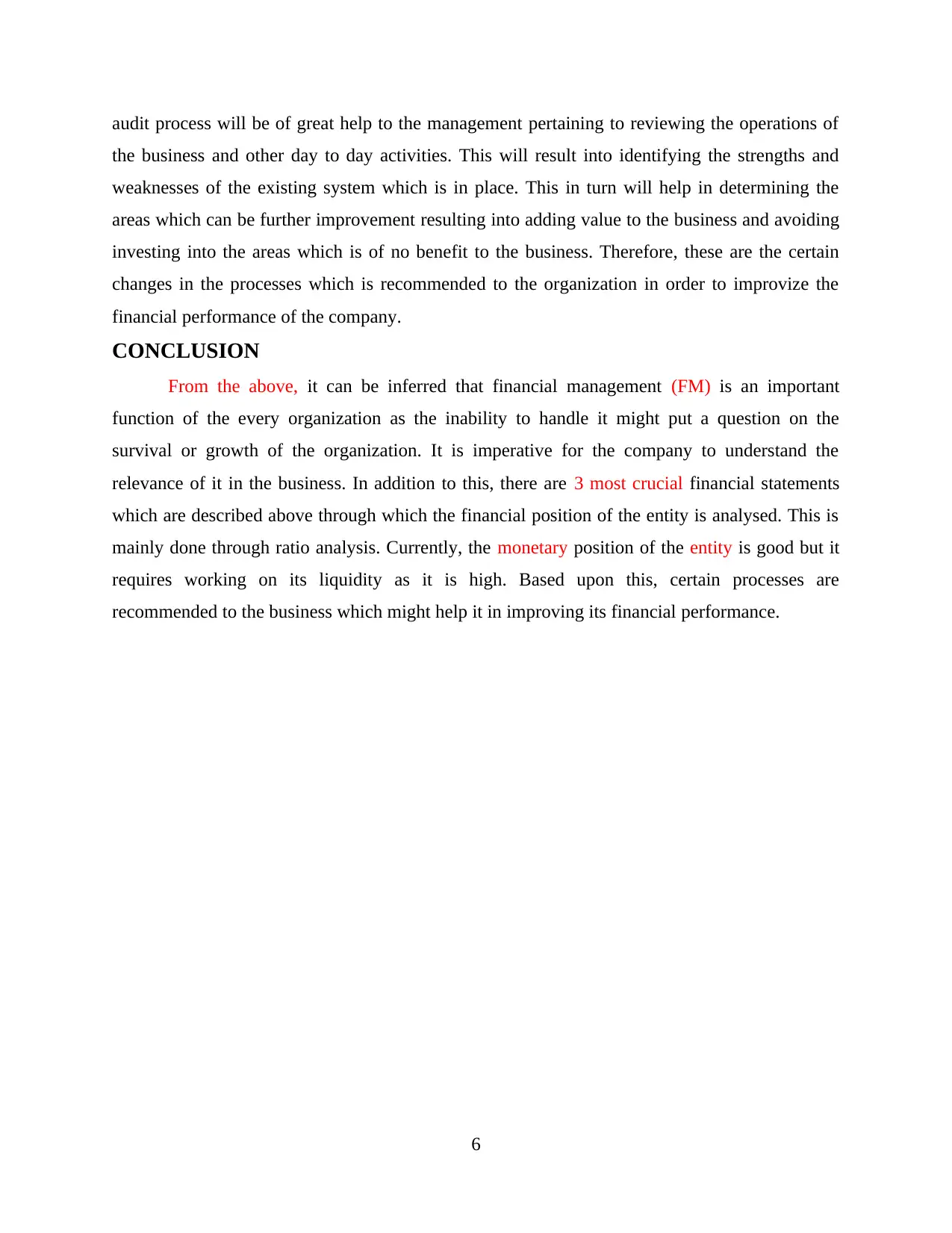
audit process will be of great help to the management pertaining to reviewing the operations of
the business and other day to day activities. This will result into identifying the strengths and
weaknesses of the existing system which is in place. This in turn will help in determining the
areas which can be further improvement resulting into adding value to the business and avoiding
investing into the areas which is of no benefit to the business. Therefore, these are the certain
changes in the processes which is recommended to the organization in order to improvize the
financial performance of the company.
CONCLUSION
From the above, it can be inferred that financial management (FM) is an important
function of the every organization as the inability to handle it might put a question on the
survival or growth of the organization. It is imperative for the company to understand the
relevance of it in the business. In addition to this, there are 3 most crucial financial statements
which are described above through which the financial position of the entity is analysed. This is
mainly done through ratio analysis. Currently, the monetary position of the entity is good but it
requires working on its liquidity as it is high. Based upon this, certain processes are
recommended to the business which might help it in improving its financial performance.
6
the business and other day to day activities. This will result into identifying the strengths and
weaknesses of the existing system which is in place. This in turn will help in determining the
areas which can be further improvement resulting into adding value to the business and avoiding
investing into the areas which is of no benefit to the business. Therefore, these are the certain
changes in the processes which is recommended to the organization in order to improvize the
financial performance of the company.
CONCLUSION
From the above, it can be inferred that financial management (FM) is an important
function of the every organization as the inability to handle it might put a question on the
survival or growth of the organization. It is imperative for the company to understand the
relevance of it in the business. In addition to this, there are 3 most crucial financial statements
which are described above through which the financial position of the entity is analysed. This is
mainly done through ratio analysis. Currently, the monetary position of the entity is good but it
requires working on its liquidity as it is high. Based upon this, certain processes are
recommended to the business which might help it in improving its financial performance.
6
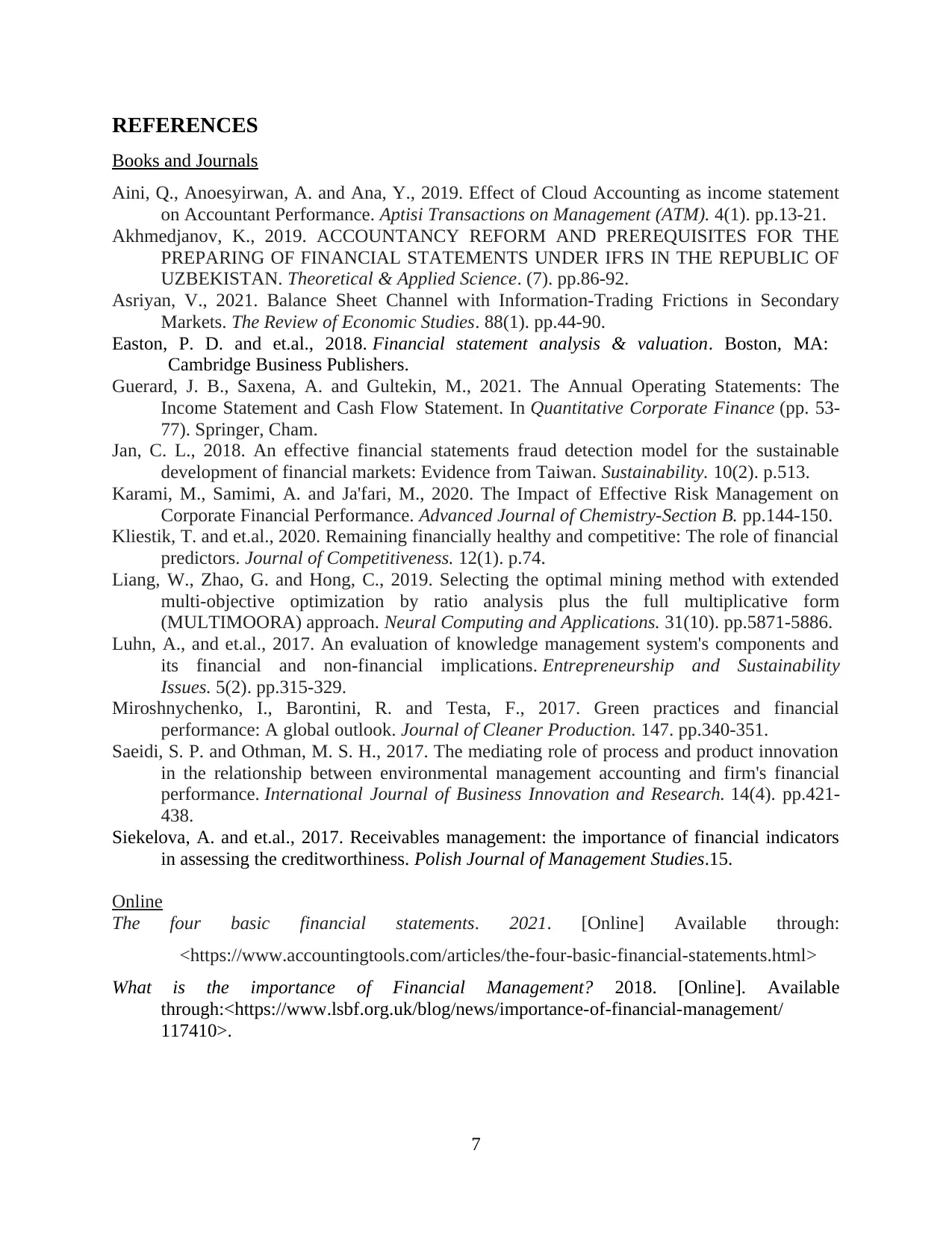
REFERENCES
Books and Journals
Aini, Q., Anoesyirwan, A. and Ana, Y., 2019. Effect of Cloud Accounting as income statement
on Accountant Performance. Aptisi Transactions on Management (ATM). 4(1). pp.13-21.
Akhmedjanov, K., 2019. ACCOUNTANCY REFORM AND PREREQUISITES FOR THE
PREPARING OF FINANCIAL STATEMENTS UNDER IFRS IN THE REPUBLIC OF
UZBEKISTAN. Theoretical & Applied Science. (7). pp.86-92.
Asriyan, V., 2021. Balance Sheet Channel with Information-Trading Frictions in Secondary
Markets. The Review of Economic Studies. 88(1). pp.44-90.
Easton, P. D. and et.al., 2018. Financial statement analysis & valuation. Boston, MA:
Cambridge Business Publishers.
Guerard, J. B., Saxena, A. and Gultekin, M., 2021. The Annual Operating Statements: The
Income Statement and Cash Flow Statement. In Quantitative Corporate Finance (pp. 53-
77). Springer, Cham.
Jan, C. L., 2018. An effective financial statements fraud detection model for the sustainable
development of financial markets: Evidence from Taiwan. Sustainability. 10(2). p.513.
Karami, M., Samimi, A. and Ja'fari, M., 2020. The Impact of Effective Risk Management on
Corporate Financial Performance. Advanced Journal of Chemistry-Section B. pp.144-150.
Kliestik, T. and et.al., 2020. Remaining financially healthy and competitive: The role of financial
predictors. Journal of Competitiveness. 12(1). p.74.
Liang, W., Zhao, G. and Hong, C., 2019. Selecting the optimal mining method with extended
multi-objective optimization by ratio analysis plus the full multiplicative form
(MULTIMOORA) approach. Neural Computing and Applications. 31(10). pp.5871-5886.
Luhn, A., and et.al., 2017. An evaluation of knowledge management system's components and
its financial and non-financial implications. Entrepreneurship and Sustainability
Issues. 5(2). pp.315-329.
Miroshnychenko, I., Barontini, R. and Testa, F., 2017. Green practices and financial
performance: A global outlook. Journal of Cleaner Production. 147. pp.340-351.
Saeidi, S. P. and Othman, M. S. H., 2017. The mediating role of process and product innovation
in the relationship between environmental management accounting and firm's financial
performance. International Journal of Business Innovation and Research. 14(4). pp.421-
438.
Siekelova, A. and et.al., 2017. Receivables management: the importance of financial indicators
in assessing the creditworthiness. Polish Journal of Management Studies.15.
Online
The four basic financial statements. 2021. [Online] Available through:
<https://www.accountingtools.com/articles/the-four-basic-financial-statements.html>
What is the importance of Financial Management? 2018. [Online]. Available
through:<https://www.lsbf.org.uk/blog/news/importance-of-financial-management/
117410>.
7
Books and Journals
Aini, Q., Anoesyirwan, A. and Ana, Y., 2019. Effect of Cloud Accounting as income statement
on Accountant Performance. Aptisi Transactions on Management (ATM). 4(1). pp.13-21.
Akhmedjanov, K., 2019. ACCOUNTANCY REFORM AND PREREQUISITES FOR THE
PREPARING OF FINANCIAL STATEMENTS UNDER IFRS IN THE REPUBLIC OF
UZBEKISTAN. Theoretical & Applied Science. (7). pp.86-92.
Asriyan, V., 2021. Balance Sheet Channel with Information-Trading Frictions in Secondary
Markets. The Review of Economic Studies. 88(1). pp.44-90.
Easton, P. D. and et.al., 2018. Financial statement analysis & valuation. Boston, MA:
Cambridge Business Publishers.
Guerard, J. B., Saxena, A. and Gultekin, M., 2021. The Annual Operating Statements: The
Income Statement and Cash Flow Statement. In Quantitative Corporate Finance (pp. 53-
77). Springer, Cham.
Jan, C. L., 2018. An effective financial statements fraud detection model for the sustainable
development of financial markets: Evidence from Taiwan. Sustainability. 10(2). p.513.
Karami, M., Samimi, A. and Ja'fari, M., 2020. The Impact of Effective Risk Management on
Corporate Financial Performance. Advanced Journal of Chemistry-Section B. pp.144-150.
Kliestik, T. and et.al., 2020. Remaining financially healthy and competitive: The role of financial
predictors. Journal of Competitiveness. 12(1). p.74.
Liang, W., Zhao, G. and Hong, C., 2019. Selecting the optimal mining method with extended
multi-objective optimization by ratio analysis plus the full multiplicative form
(MULTIMOORA) approach. Neural Computing and Applications. 31(10). pp.5871-5886.
Luhn, A., and et.al., 2017. An evaluation of knowledge management system's components and
its financial and non-financial implications. Entrepreneurship and Sustainability
Issues. 5(2). pp.315-329.
Miroshnychenko, I., Barontini, R. and Testa, F., 2017. Green practices and financial
performance: A global outlook. Journal of Cleaner Production. 147. pp.340-351.
Saeidi, S. P. and Othman, M. S. H., 2017. The mediating role of process and product innovation
in the relationship between environmental management accounting and firm's financial
performance. International Journal of Business Innovation and Research. 14(4). pp.421-
438.
Siekelova, A. and et.al., 2017. Receivables management: the importance of financial indicators
in assessing the creditworthiness. Polish Journal of Management Studies.15.
Online
The four basic financial statements. 2021. [Online] Available through:
<https://www.accountingtools.com/articles/the-four-basic-financial-statements.html>
What is the importance of Financial Management? 2018. [Online]. Available
through:<https://www.lsbf.org.uk/blog/news/importance-of-financial-management/
117410>.
7
⊘ This is a preview!⊘
Do you want full access?
Subscribe today to unlock all pages.

Trusted by 1+ million students worldwide
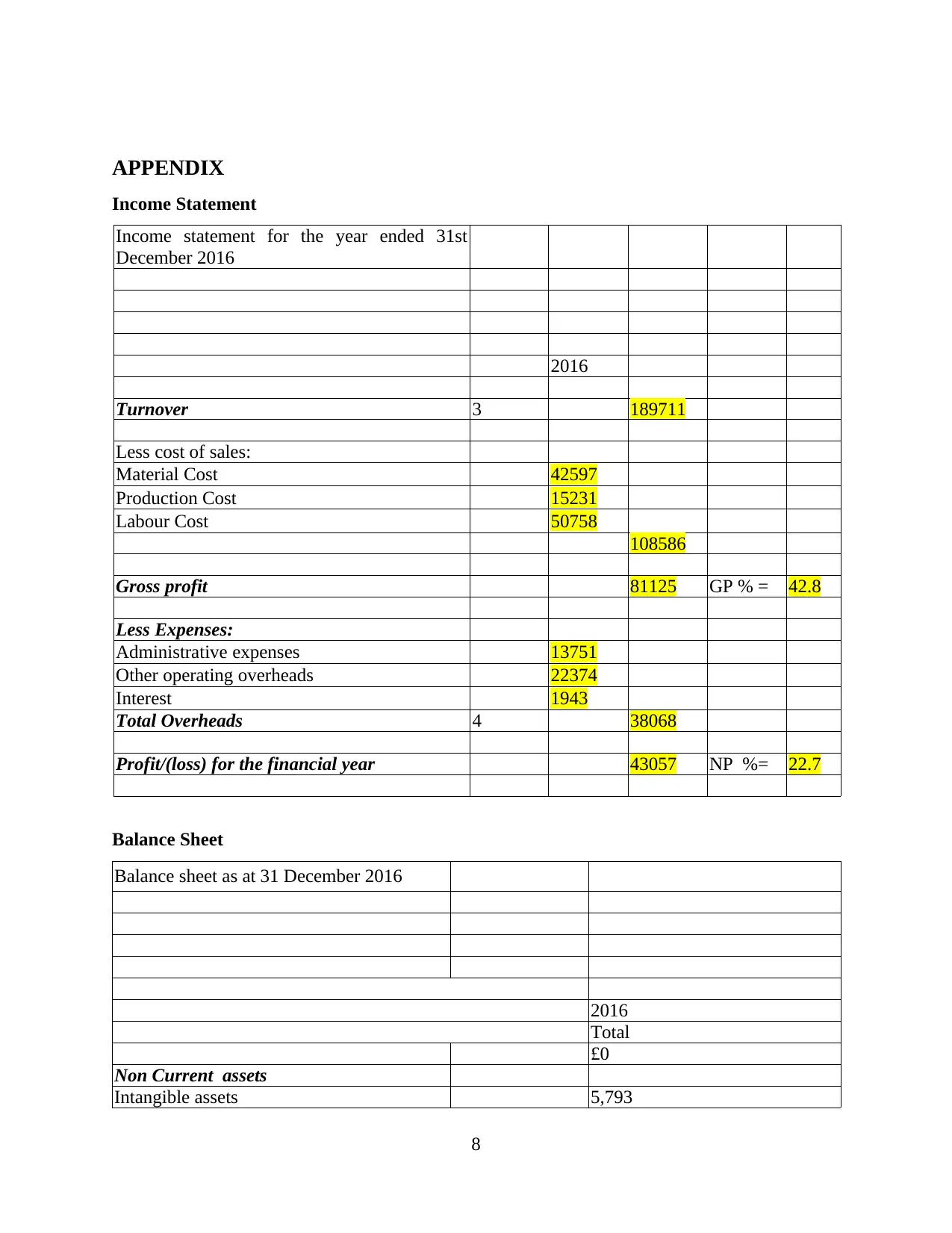
APPENDIX
Income Statement
Income statement for the year ended 31st
December 2016
2016
Turnover 3 189711
Less cost of sales:
Material Cost 42597
Production Cost 15231
Labour Cost 50758
108586
Gross profit 81125 GP % = 42.8
Less Expenses:
Administrative expenses 13751
Other operating overheads 22374
Interest 1943
Total Overheads 4 38068
Profit/(loss) for the financial year 43057 NP %= 22.7
Balance Sheet
Balance sheet as at 31 December 2016
2016
Total
£0
Non Current assets
Intangible assets 5,793
8
Income Statement
Income statement for the year ended 31st
December 2016
2016
Turnover 3 189711
Less cost of sales:
Material Cost 42597
Production Cost 15231
Labour Cost 50758
108586
Gross profit 81125 GP % = 42.8
Less Expenses:
Administrative expenses 13751
Other operating overheads 22374
Interest 1943
Total Overheads 4 38068
Profit/(loss) for the financial year 43057 NP %= 22.7
Balance Sheet
Balance sheet as at 31 December 2016
2016
Total
£0
Non Current assets
Intangible assets 5,793
8
Paraphrase This Document
Need a fresh take? Get an instant paraphrase of this document with our AI Paraphraser
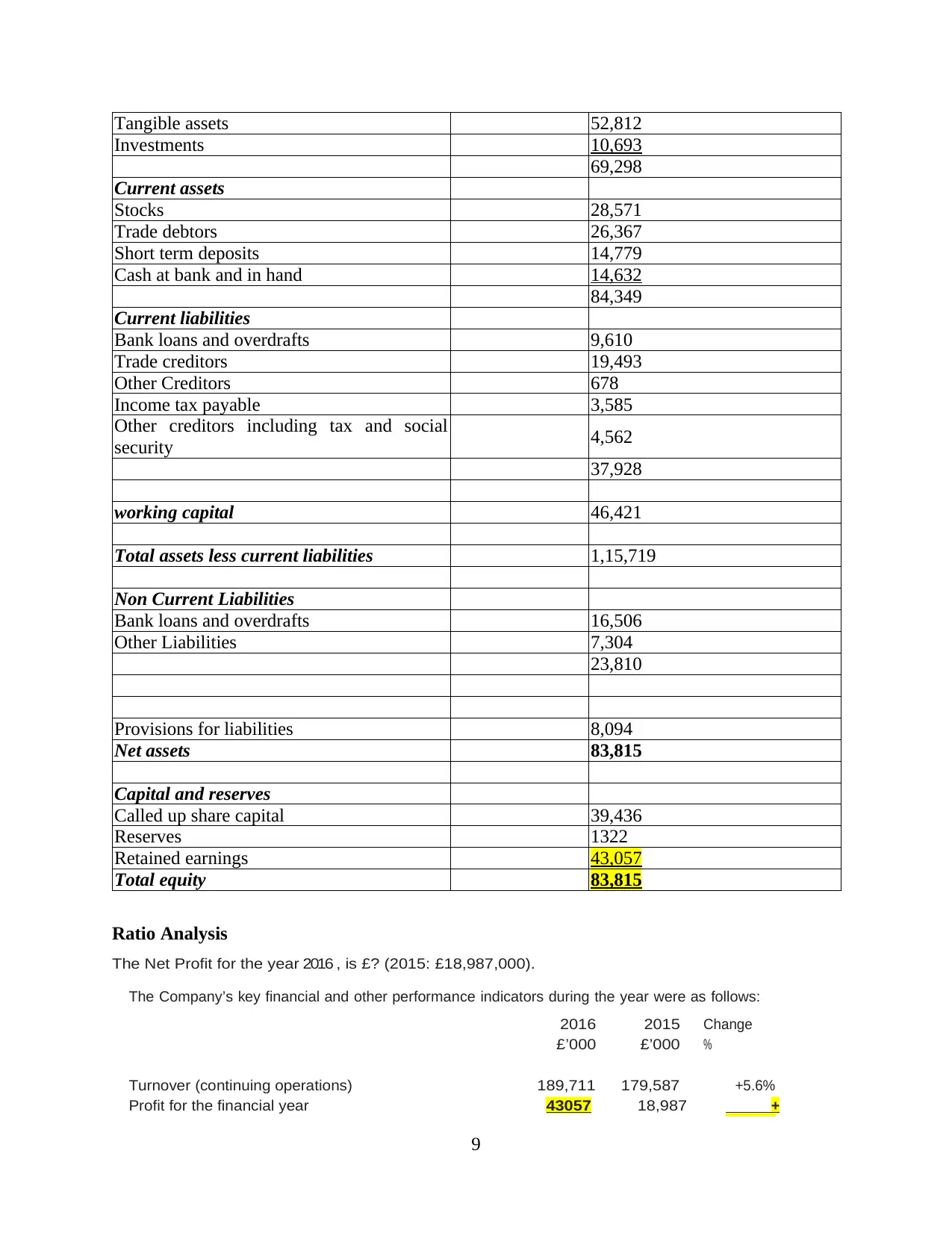
Tangible assets 52,812
Investments 10,693
69,298
Current assets
Stocks 28,571
Trade debtors 26,367
Short term deposits 14,779
Cash at bank and in hand 14,632
84,349
Current liabilities
Bank loans and overdrafts 9,610
Trade creditors 19,493
Other Creditors 678
Income tax payable 3,585
Other creditors including tax and social
security 4,562
37,928
working capital 46,421
Total assets less current liabilities 1,15,719
Non Current Liabilities
Bank loans and overdrafts 16,506
Other Liabilities 7,304
23,810
Provisions for liabilities 8,094
Net assets 83,815
Capital and reserves
Called up share capital 39,436
Reserves 1322
Retained earnings 43,057
Total equity 83,815
Ratio Analysis
The Net Profit for the year 2016 , is £? (2015: £18,987,000).
The Company’s key financial and other performance indicators during the year were as follows:
2016
£’000
2015
£’000
Change
%
Turnover (continuing operations) 189,711 179,587 +5.6%
Profit for the financial year 43057 18,987 +
126.7%
9
Investments 10,693
69,298
Current assets
Stocks 28,571
Trade debtors 26,367
Short term deposits 14,779
Cash at bank and in hand 14,632
84,349
Current liabilities
Bank loans and overdrafts 9,610
Trade creditors 19,493
Other Creditors 678
Income tax payable 3,585
Other creditors including tax and social
security 4,562
37,928
working capital 46,421
Total assets less current liabilities 1,15,719
Non Current Liabilities
Bank loans and overdrafts 16,506
Other Liabilities 7,304
23,810
Provisions for liabilities 8,094
Net assets 83,815
Capital and reserves
Called up share capital 39,436
Reserves 1322
Retained earnings 43,057
Total equity 83,815
Ratio Analysis
The Net Profit for the year 2016 , is £? (2015: £18,987,000).
The Company’s key financial and other performance indicators during the year were as follows:
2016
£’000
2015
£’000
Change
%
Turnover (continuing operations) 189,711 179,587 +5.6%
Profit for the financial year 43057 18,987 +
126.7%
9
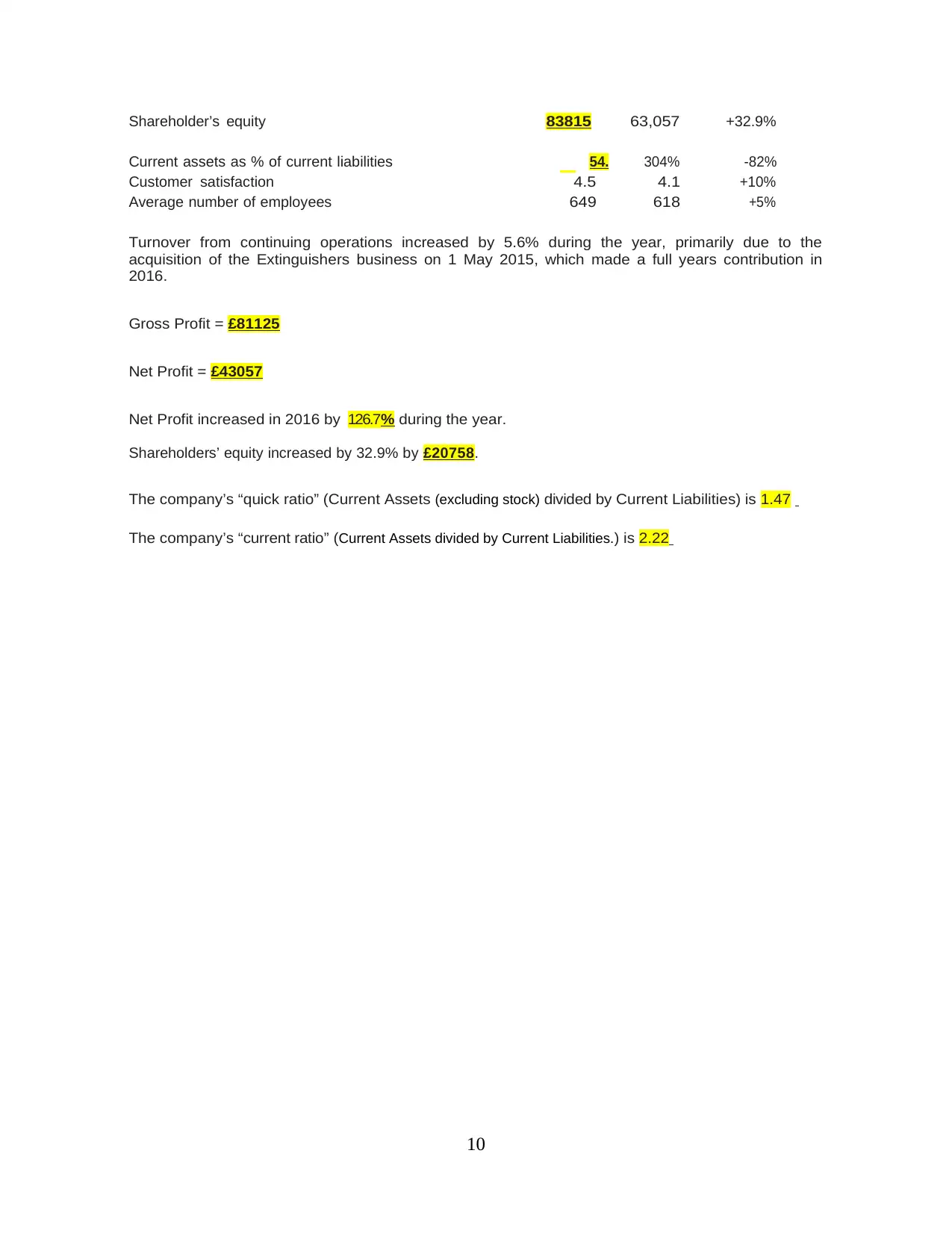
Shareholder’s equity 83815 63,057 +32.9%
Current assets as % of current liabilities 54.
72%
304% -82%
Customer satisfaction 4.5 4.1 +10%
Average number of employees 649 618 +5%
Turnover from continuing operations increased by 5.6% during the year, primarily due to the
acquisition of the Extinguishers business on 1 May 2015, which made a full years contribution in
2016.
Gross Profit = £81125
Net Profit = £43057
Net Profit increased in 2016 by 126.7% during the year.
Shareholders’ equity increased by 32.9% by £20758.
The company’s “quick ratio” (Current Assets (excluding stock) divided by Current Liabilities) is 1.47
The company’s “current ratio” (Current Assets divided by Current Liabilities. ) is 2.22
10
Current assets as % of current liabilities 54.
72%
304% -82%
Customer satisfaction 4.5 4.1 +10%
Average number of employees 649 618 +5%
Turnover from continuing operations increased by 5.6% during the year, primarily due to the
acquisition of the Extinguishers business on 1 May 2015, which made a full years contribution in
2016.
Gross Profit = £81125
Net Profit = £43057
Net Profit increased in 2016 by 126.7% during the year.
Shareholders’ equity increased by 32.9% by £20758.
The company’s “quick ratio” (Current Assets (excluding stock) divided by Current Liabilities) is 1.47
The company’s “current ratio” (Current Assets divided by Current Liabilities. ) is 2.22
10
⊘ This is a preview!⊘
Do you want full access?
Subscribe today to unlock all pages.

Trusted by 1+ million students worldwide
1 out of 12
Related Documents
Your All-in-One AI-Powered Toolkit for Academic Success.
+13062052269
info@desklib.com
Available 24*7 on WhatsApp / Email
![[object Object]](/_next/static/media/star-bottom.7253800d.svg)
Unlock your academic potential
Copyright © 2020–2025 A2Z Services. All Rights Reserved. Developed and managed by ZUCOL.

